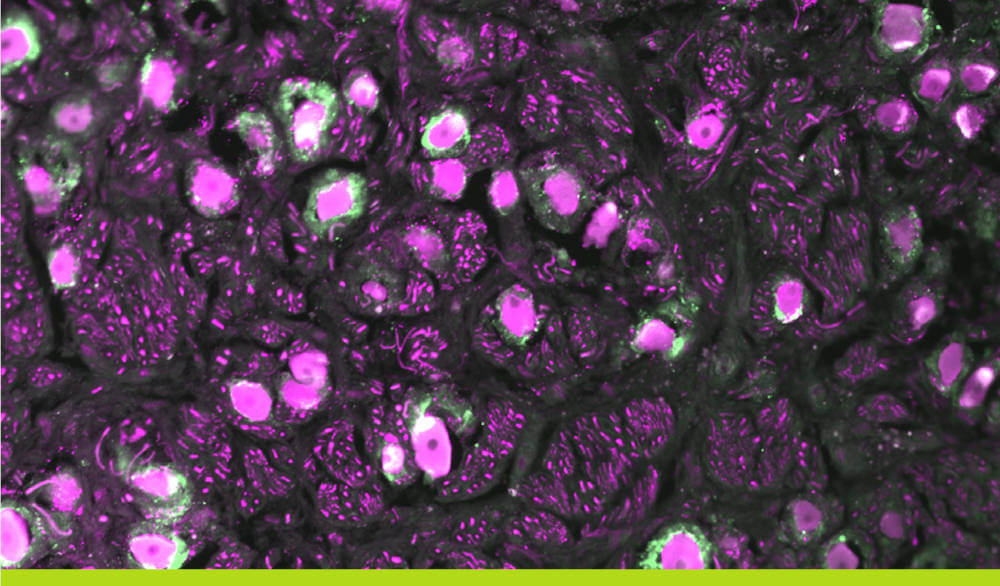

WOMEN IN SCIENCE
STEM EXPERT SPOTLIGHT
Photo credit: Oshri Avraham, PhD
Satellite glial cells (green) surround dorsal root ganglia (magenta), which are clusters of neurons near the spinal cord that transmit sensory information.
Glia:
Unsung Heroes of the Nervous System
For centuries, scientists have been captivated by the complexity and diversity of cells in the nervous system, from Luigi Galvani’s Frankenstein-like experiments in frogs that discovered the importance of electricity in nerves in 1780, to the beautiful drawings of cells in the nervous system by Santiago Ramón y Cajal throughout the 1800s. The human brain alone consists of 171 billion cells, but only about half of those are the neurons for which the whole system is named. The other half of the brain consists of cells called glia, meaning “glue,” but these cells do much more than just hold neurons in place. While they may not have the same fame as neurons, glia are essential to healthy, functional brains.
There are numerous types of glia in the nervous system, and in recent years scientists have uncovered a multitude of roles they play. Here, we’ll get to know a few different types of glia and how researchers at Washington University are helping develop a better understanding of the important ways these unsung heroes impact both the brain and the body.
Astrocytes:
A Starring Role in Brain Function
While there are many types of glial cells that contribute to a healthy nervous system, none is as abundant as the astrocyte, which accounts for 40% of glia in the brain. Because these star-shaped cells connect blood vessels and neurons scientists thought that the primary role of astrocytes must be to feed neurons, by pulling nutrients from the blood. However, astrocyte biologists such as Dr. Thomas Papouin, assistant professor at Washington University School of Medicine, dispute this idea: “Astrocytes are not supportive cells, or helpers, or housekeepers, as we often hear…If anything, it is probably the opposite: they might very well be the master orchestrator of brain function, the key to understanding and unlocking the mysteries of the brain.”
When contacting neurons, astrocytes do not simply deliver nutrients. They can also change the way in which neurons communicate with each other by taking up signals released from neurons, altering the ionic environment and even sending their own signals to neurons directly. We are still learning all the ways in which astrocytes are a part of healthy brain activity, but one thing is clear: without them, our neurons would not be enough for a fully functional nervous system!

Photo credit: Oshri Avraham, PhD
Dorsal root ganglia (magenta) enveloped by satellite glial cells (green).
Microglia in Development:
Small but Mighty
Building a fully functional nervous system from scratch is a complex task for an embryo, requiring a diverse set of cells, each with their own expertise. One cell type that is crucial for brain development is microglia, a small and mobile cell that plays several roles throughout our lifetime. Microglia take charge in shaping development in two major ways.
They directly shape neural circuits—connected neurons that serve a particular function—by eating unwanted connections and cells to make sure the brain is a well-run machine. Additionally, they send out signals called cytokines that can direct the complex choreography of cell development and neural circuit formation.
The ways in which microglia shape the developing system are complex and still being untangled by scientists such as Dr. Tristan Li, assistant professor at Washington University.
“[V]ery few questions in neuroscience, if any, would be fully answered if we do not consider glia within the nervous system.”
Losing microglia during development leads to disorganized communication between neurons, and between neurons and glia, too. Microglia may be small, but they are workhorse cells setting up the nervous system.
Satellite Glial Cells:
Beyond the Brain
Glial cells are not only confined to the brain. Satellite glia wrap around nerves outside the brain and spinal cord in what’s called the periphery, with each satellite glial cell covering one or two neurons.
“This morphology is there for a reason,” says Dr. Valeria Cavalli, the Robert E. and Louise F. Dunn Professor of Biomedical Research at Washington University, who studies how satellite glia are involved in nerve injury and regeneration. “And a better understanding of how they interact with the neuron might help understand many diseases and disorders related to peripheral nerves.”
Unlike neurons in the brain, nerves in the periphery can recover after they have been damaged, and the key to this recovery may be found in satellite glia. In addition, satellite glial cells can play a significant role in pain after injury. One of the most important ways in which satellite glia contribute to chronic pain is by changing the environment around neurons that carry pain signals, making them overly sensitive to painful stimuli. Chronic pain has been remarkably difficult to treat previously, but with new knowledge on the role of satellite glia, researchers have fresh opportunities to develop potential treatments that target these peripheral cells.
Fascinating Facts About Glia:
- 1. Microglia
- 2. Astrocytes
- 3. Oligodendrocytes
- 4. NG2-glia






